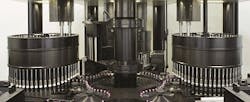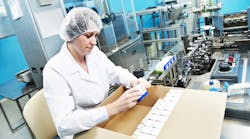Editor's Note: This article originally included the sidebar, Bioreactor Preferences from an Outsourcing Perspective – Part I
Maslow wrote, “I suppose it is tempting, if the only tool you have is a hammer, to treat everything as if it were a nail.” For decades, Pharma’s been engineering its own “hammer,” creating development and production methodologies that tended to treat every potential drug candidate like the proverbial nail. To many, Pharma’s hammer became too heavy to wield, not only inefficient at driving Pharma’s traditional solid-dose nails but increasingly ineffective at addressing quality issues at the manufacturing level for biopharmaceuticals. Since FDA promulgated Pharmaceutical cGMPs for the 21st Century: A Risk-Based Approach, drug makers have invested in its principles slowly if not grudgingly — with some more enthusiastic about it than others, but to a certain extent, it’s now generally accepted as the gospel truth. As many should be aware by now, the FDA’s first principle leaves little doubt about regulators’ intentions: “To encourage the early adoption of new technological advances by the pharmaceutical industry.”
Janet Woodcock, director for the Food and Drug Administration’s (FDA’s) Center for Drug Evaluation and Research offered this at PDA’s 2014 Annual Meeting: “The pharmaceutical manufacturing landscape has really changed over the past decade and is continuing to evolve rather quickly,” she said. “FDA’s regulatory approach is also going to have to evolve to keep up, and some of the most significant changes — including the massive shift from domestic to overseas manufacturing sites, which has affected all of you as well as the FDA — [plus] rising contract manufacturing, the fragmentation of stages of manufacturing, not only by ownership but also by geography and diversification of suppliers.”
The AIM 8 inspection machine for vials is the first of the new, modular generation of fully automated inspection machines by the Inspection Technology sector of Bosch Packaging Technology.
Woodcock and her regulatory colleagues have also recognized that in spite of its intentions framing Pharmaceutical cGMPs for the 21st Century, the agency’s own compliance infrastructure became a barrier to adopting the principles of its own guidance. In response, Woodcock offered PDA’s attendees this: “So we’re going to set up a team to deal with really advanced manufacturing so that you would have ‘go-to’ people. If you want to establish some advanced technology you can talk to that team — they would help shepherd it through the regulatory process, including continuous processing, using statistical process control.”
Alas, “encouraging” the industry to do something is one thing; actually getting it to do something is another! OK, so folks’ heads are in the right place, but in the great continuum of Pharma manufacturing, where is the industry these days when it comes to living the philosophy in day-to-day manufacturing operations?
Recent data does show capital is being carefully invested in “current” process and manufacturing technologies, purchasing that’s supporting a slow but continuing retooling to address the market’s crazy complexity.
GE Capital’s 2014 “Healthcare Industry Economic Outlook Survey” queried 86 middle market healthcare industry service and product firms ranging from $10 million - <$1 billion in sales. According to GE Capital, the majority expect capital spending to remain flat with about 30 percent planning a modest (1 to 5 percent) increase. While GE Capital’s findings included companies outside pharmaceutical manufacturing, the results provided a benchmark within the sector. GE Analysts found one of the more “significant” insights to emerge from the study included the opinion that firms are facing margin pressures due to the challenges of growing revenues while coping with the costs of business.
GE Capital highlighted the fact that capital expenditures are likely to focus on replacement of existing equipment, infrastructure maintenance and new equipment purchases. Although recent industry studies reveal a general leveling off with large-cap Pharma moderating capital spending, spending activity from mid-cap firms — like the generic producers, CMOs and the CRDOs — may be ramping up to capture the business that’s being shed by larger Pharma. GE Healthcare analyst and senior vice president Savant Ahmed added this color to GE’s findings: “I think what you’re seeing is actually fairly interesting,” says Savant. “We are seeing the same trend now spreading to [companies like] Teva and Activis — as well as more of the [biopharmaceutical] pharma side as well.”
Savant notes those firms are pretty big in their own right and are carrying some of the same burdens that large-cap Pharma firms used to have exclusive rights to. “With those larger companies, you see CapEx coming down. I think the lag is being picked up by other companies, but it’s being done in two ways: One, they’re just taking over the capacity that large-cap pharma is getting rid of. So it’s not new CapEx. It’s basically transfer of assets, so the implications of that are different than if it was like new business.”
Nevertheless, there’s only so much capacity Pharma can use, but in light of market and competitive pressures, as well as what some might term the “neglect” of the aging pharmaceutical manufacturing fleet, there’s only so much idle capacity that’s cost-effective to utilize. “Clearly if you look at some capacity, which is very old … it tends to be less on the [solid dose] manufacturing side, but more in the sterile injectable side. A lot of that capacity is old and probably needs to be torn down,” says Savant.
It’s increasingly clear that Branded Pharma is turning to contract manufacturing organizations (CMOs) to achieve the FDA’s vision of the “early adoption of new technological advances by the pharmaceutical industry.” Patheon and its parent DPx Holdings are at the forefront of this trend, seeking not only to innovate, but also to lead the industry in integrating and institutionalizing advanced manufacturing solutions and to bring said advancements to their customers.
Bill Weiser, Ph.D., Global Head, PDS Analytical Sciences for Patheon, explains that value for his company’s customers is created by delivering speed and productivity. “When you talk about speed there’s certainly the efficiency of manufacturing and making sure that we have the right size equipment for the job that we’re after,” says Weiser, “but it’s also speed of development; so in other words, if there’s an opportunity for us to accelerate a development program or essentially find the right fit, that creates value for our customers.” Speed is one key area, says Weiser, but so is productivity. “For instance, in the solid dose manufacturing area we have made a commitment to continuous manufacturing based on its scalability, process control, and overall operational costs, including footprint.” A declaration, which on its face, is interesting because it’s a common meme in the industry that continuous manufacturing will only deliver its value when it’s applied to the super-high volume, commercial-scale production of (primarily) solid dose forms.
Further, say critics, Pharma is loath to adopt continuous process methodologies (among other things) because in spite of everything, profit margins are so high they can afford the incumbent costs of traditional commercial-scale production methodologies at aging but functional facilities (along with quality excursions and regulatory sanctions) and have no financial incentive to invest in … wait for it … “the early adoption of new technological advances.”
Weiser says Patheon is committed to CM for some very good reasons. “One is speed and it’s speed both from a development aspect — in other words the ability to go through a number of iterations of formulations design, as well as being able to achieve the right scale for a manufacturing operation.” Weiser says this is particularly true during development: “The ability to provide appropriate material for a Phase I or Phase II study, and then be able to very rapidly scale to a larger scale for a Phase III study — essentially just using a continuous train,” notes Weiser, “is an opportunity to add value to our customers’ programs. So we’re involved in that and really beginning to make significant new roads in [CM] technology.”
Excellent because the economies associated with CM seem to make very pragmatic business sense, for a drug owner especially if the outfit has a very promising compound that’s likely to have decent commercial volumes once it’s approved and hits the market. It makes sense then to seek these capabilities and, thinking longer term, understand the potential of a partner that is ready to be with them for at least the first part of that long haul. Weiser agrees, noting “Pharma has really lagged behind other industries in adopting continuous manufacturing. If you think about it, wouldn’t it be great to be about to have a process that you could generate sufficient material for a phase two study, and if you rapidly need to go into Phase III that you could accomplish that through basically just running an equipment train longer?” It sure would, Dr. Weiser.
“And if you think about it, scalability is critical for initiating Phase III studies — phase two studies tend to be fairly modest in requirements, but the population for Phase III can be quite substantial — and I think it’s those areas where you want to ramp up quickly, or if you have a disease that has a unique therapy solution and a fast-track from regulators, where CM makes a lot of sense.” Weiser put it this way: “Get a fast track designation and all of a sudden you’ve got a good read on Phase II and you’re off to the races in Phase III.”
EXPANDING THE POSSIBILITIES
Last year, contract manufacturer and packager Pharma Tech Industries announced its intention to expand its Union, Missouri, production facility, adding some 60,000 sq. ft. of manufacturing space for a total of 160,000 sq. ft. The new space, says Pharma Tech Industries, will support production of ingestible powders and will feature a production room built to ISO Class 8/100,000 cleanroom standards. The expansion, scheduled to be completed in March, has all the earmarks of a business strategy supported by enhancing and developing manufacturing operations. PTI recently upgraded its 270,000-sq.-ft. facility in Royston, Georgia, adding an analytical laboratory to broaden its on-site testing for both prescription and over-the-counter drugs. Pharma Tech Industries, says its analytical services, will deploy High Pressure Liquid Chromatography (HPLC) for Assay/Impurity profiles of liquids and powders; Quantitative/Qualitative Fourier Transform Infrared (FTIR) Spectroscopy; Particle Size Analysis of powders by Laser Diffraction; and Gas Chromatography (GC) analysis.
“Our latest expansion and upgrade projects reflect not only an increase in the volume of overall business, but in the variety of manufacturing services that Pharma Tech Industries can offer to customers,” explains Tee Noland, chairman of Pharma Tech Industries, in the release. “These projects are in line with our goal of responsible, gradual growth that allows PTI to reach into new areas while continuing to refine and hone existing capabilities.” PTI produces more than 300 SKUs of powders and effervescent and solid dose products along with cotton swabs and injection molded components.
What systems or technical platforms does Noland think are delivering great value and competitive advantage to Pharma Tech Industries’ customers? “At Pharma Tech we look at technology as a key enabler of our processes and service. For example,” he says, “we manage our largest customer relationship via inventory replenishment through an integrated ERP system that communicates directly with our customer’s ERP system. We also are looking to digitize more of our quality documentation to reduce related errors and improve customer responsiveness, explains Noland. In addition, he says, nearly all of Pharma Tech Industries’ production equipment has systems tied to them in terms of preventative maintenance, shop floor, etc., to help the company maintain and improve production assets.
Prepackaged, sterile, ready-to-fill vials like these from Schott inject efficiencies into parenteral production lines.
EXTREMELY SHARP
Besides capacity, Pharma Tech Industries also appears to be intent on applying best practices when it comes to informatics and other information technologies that no one can argue are not extremely sharp tools to help craft operational excellence both from a process and quality systems point of view. “We are really looking to beef up our performance dashboard systems in finance,” says Noland, “specifically so we can get the right information to the right people at the right time to help them prioritize what they need to do.”
NICE PACKAGING
Friedbert Klefenz has been president of Bosch Packaging Technology since April 2002. Since his tenure began, Klefenz has played a pivotal role in Bosch’s ascension to an undeniably strong leadership position in this segment of Pharma processing technology. Pharmaceutical Manufacturing caught up with Herr Klefenz at PackExpo to talk about trends in packaging technology and Bosch’s role in supporting Pharma’s quest for faster, reliable and more versatile systems to handle this increasingly important element of the drug manufacturing value chain. Bosch had a pretty good run, topping $1 billion in sales 2013 and experiencing 20 percent growth from the year prior. Pharma, he said, was a big driver of this business with Klefenz characterizing the company’s growth in Pharma as “huge,” with more sales to European Pharma firms than he expected, given its sluggish economy.
While Klefenze does not necessarily agree that Pharma’s on some CapEx spending spree, he explained that Pharma’s spending is dictated by its own particular market environment: “Pharmaceutical companies have a different cycle compared to the economy in the world; one of the pharmaceutical cycles is related to … new product which goes in the pipeline.”
Again, it’s not about how Pharma is spending, or how much, but what they’re spending it on, and Klefenz agrees that Pharma is looking for optimization — everything in the pursuit of quality and risk management — and higher performing, more reliable, better connected systems.
For packaging systems, the framing science has more to do with physics than chemistry, and the systems, especially the high-speed, high-capacity ones, are masterful expressions of industrial automation and electromechanical “magic” that bring new meaning to “state-of-the-art.” Bosch had some amazing machines on display, with a dazzling array of well-targeted solutions including its AIM 8 tablet inspector that prepare final dosage forms for their eventual distribution and consumption.
FLEXIBILITY DELIVERED
SCHOTT recently announced it is advancing to full-scale production of its new system for ready-to-use pharmaceutical vials at the company’s U.S. facility in Lebanon, Pennsylvania, in preparation for their commercial launch. If one can imagine the hundreds of thousand of vials a parenteral drug maker or CMO filler handles and processes for high-demand sterile injectables, one can also easily imagine that pre-staged, sterilized vials can save manufacturers major time and money.
Designed in close collaboration with filling-line manufacturers to meet the industry’s process requirements, SCHOTT vial system consists of a patented nest that securely holds up to 100 clean and sterile vials in an industry-standard tub. SCHOTT says users can load these directly onto their filling lines without having to perform arduous processing steps, such as washing, drying and sterilizing. Besides simplifying the process, the new nested packaging protects the glass containers from scratches caused by vial-to-vial and vial-to-machine contact. According to Cassidy, “SCHOTT discusses its product ideas with filling line manufacturers such as Bosch Packaging Technology, Bausch+Stroebel, GEA, OPTIMA and VANRX during the development phase.“
“Since introducing the adaptiQ concept, we have received strong interest from our customers,” said Christopher Cassidy, vice president for the Pharmaceutical Packaging Business Unit at SCHOTT. “Pharmaceutical companies are seeking packaging solutions that enable them to use their existing filling lines in a more flexible way. In order to achieve this, our vial system is oriented toward the proven tub format used in syringe manufacturing,” explains Cassidy. “This means pharmaceutical companies can use the same production line for various types of containers and formats by adjusting only the filling and closing station to the chosen container format. This helps significantly shorten set-up times for changing drug and packaging configurations.”
BETTER TOOLS FOR BIOLOGICS
Pharma’s headlines are dominated by news from biopharmaceutical companies announcing acquisitions, plant expansions and new drug approvals. What equipment is “trending” in BioPharma? Biologics manufacturers are under the gun because the process is often the product when it comes to the therapies these companies are producing. Among the technologies bringing quality and competitive agility, single-use technologies, analytics and informatics are bringing home the bacon for BioPharma.
Biogen Idec recently won approvals for ELOCTATE and ALPROLIX its new Hemophilia A and B (respectively) prophylactic infusions. Joydeep Ganguly vice president of manufacturing and general manager of Biogen Idec’s Research Triangle Park, N.C.,operations paints a picture of his facility. “In Biogen’s history, the RTP facilities are state of the art and world class.” Ganguly notes the phrase “word-class” is very cliché. “But it is world-class, and it’s because it was designed in a very thoughtful and very scalable fashion.” There have been considerable investments made over the evolution of the facility says Ganguly, “In 2006, [Biogen Idec] did a huge technology map project [which] upgraded the capacity of the facility. We are in the process right now of putting a new harvest suite in place.” Ganguly says the facility is generally always in a state of positive flux, constantly reinventing itself. “If you take a look at any point in time,” says Ganguly, “I would be comfortable saying that it would rank as one of the more contemporary facilities within the sterile biotic facilities.”
Ganguly agreed that incremental advancements in all aspects bioprocessing, as well as affordable access to technologies (like single-use and analytics)—are bringing the agility, the efficiencies and the risk management BiogenIdec and its peers are demanding, delivering a new dimension to operations of this scale.
Regarding single-use, “it’s not the singular reason why we’re getting efficiency,” says Ganguly, “it’s a combination of facility upgrade, moving to better technologies and moving to high-capacity resins, etc.” One of the things that Ganguly says is making a difference is the fact that Biogen is investing heavily in advanced control and advanced-monitoring technologies to drive efficiency because, as he so succinctly put it, “it’s very expensive manufacturing.”
Ganguly says it’s optimal to seek early predictive indicators of the health of your batch before it’s actually released. “So the ability to get production done and to see the health of the outcome of your batch can lend to an efficiency in terms of your batch losses, or not having predictable measures of success.” Waxing enthusiastically about this technology’s capability to improve operational excellence, Ganguly notes “We’ve made investments in things like cell culture monitoring technology where we have a lot of real-time cell counting methods; we’ve integrated some really cool ways of applying higher mathematical models where we’ve actually taken development data and used advanced mathematics to quantify it – the way you scale up.”
Ganguly explains that when one scales up, this data is critical. “Scaling from 2 liters to 2,000 liters—which is a huge—that is, when scaling from the lab to a large-scale manufacturing facility, modeling is extremely effective in projecting outcomes and managing risk.” And then there’s an entire space around using big data on the floor, notes Ganguly: “We have so much data at our disposal—from reactor pressure to temperature and we make this available to all our business centers.” Ganguly says BiogenIdec has a lot of informatics tools “that are on the floor right now where operations start and where we can get a very quick indication of the health of the process and create advanced mathematical models to support scale-up.” Ganguly says it was necessary for him and his colleagues to take a leadership role in establishing informatics on the plant floor to get that data. “That’s a component weaved into the fabric of our manufacturing operations, says Ganguly, summing things up, “We constantly look for ways where we try and take technologies conventionally thought of as lab equipment and try and see whether or not there’s application in our commercial-scale process trains. That is driving a lot of efficiency; not just in our company but in the overall industry in general.”
BETTER HAMMERS, MORE NAILS
For Pharma’s tool users, and for its tool makers, game-changing quality and profit boosting innovation is being led by both, but it often comes from very close collaboration at many levels. This was a common theme among the contributors to this story, where the selection of engineering and systems development firms, technology vendors and others created an environment where Pharma’s tools could be applied to meet their current and future operational and manufacturing goals.








